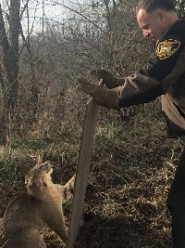 Currently, bobcats are a protected species in the State of Indiana, meaning they cannot be hunted or trapped.
Currently, bobcats are a protected species in the State of Indiana, meaning they cannot be hunted or trapped.
Between 1970 and 2014, the IDNR received bobcat reports from 63 Indiana counties. Although bobcat reports are more common in southern Indiana, confirmed reports have been received from west central and northern regions.
Recent research and trends in the number of bobcats reported to the Indiana Department of Natural Resources through the use of trail cameras photos, sightings, road-kills and other mortalities indicate the bobcat population is expanding. In 2012, 2013 and 2014 more than 60 bobcat mortalities were reported each year.
 Having bobcat populations across the state is a good thing, but it can generate questions about livestock predation, safety of pets and impacts on game birds. Conflicts between bobcats and livestock are rare. A recent report on the diet of bobcats in Indiana found they preferred prey such as rabbits and small mammals, rather than birds. To date, the IDNR has received no verified accounts of bobcats injuring a pet.
Having bobcat populations across the state is a good thing, but it can generate questions about livestock predation, safety of pets and impacts on game birds. Conflicts between bobcats and livestock are rare. A recent report on the diet of bobcats in Indiana found they preferred prey such as rabbits and small mammals, rather than birds. To date, the IDNR has received no verified accounts of bobcats injuring a pet.
Many Hoosiers have the potential to see a bobcat, but the secretive nature of bobcats makes catching a glimpse of these animals an infrequent event. As with all wildlife, if you see a bobcat, it should be respected. Nonetheless, landowners should not be afraid as the natural response of a bobcat is to flee from humans.
The bobcat is a moderate-sized member of the cat family. The name is appropriate because they sport a stubby tail only four or five inches long. Bobcats range in length from 30 to 50 inches, stand about 2 feet high and weigh from 15 to 30 pounds. Large tufts of fur on the cheeks are characteristic of the species. The fur is reddish-brown above and a whitish below, and black spots or streaks are throughout the coat. Bobcats live as long as 10 to 12 years in the wild. Eerie screams are often emitted by bobcats during the night.











